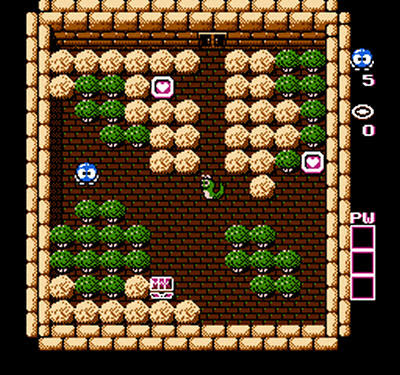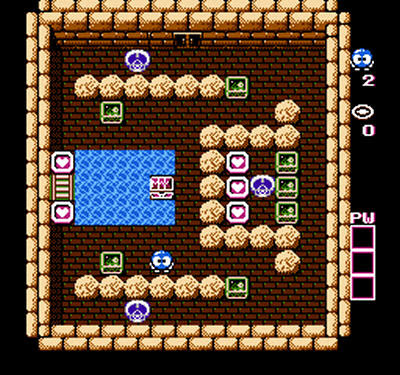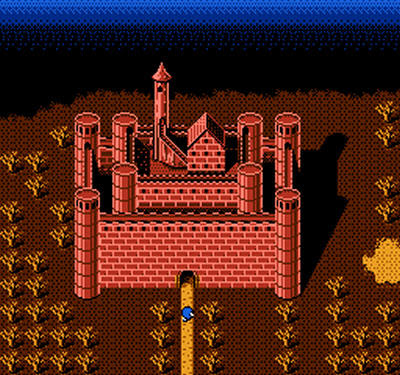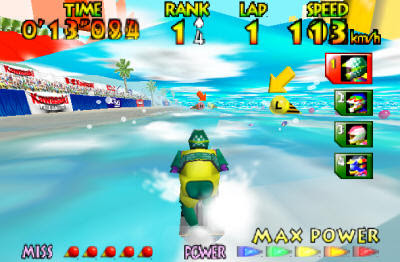This current week - the week of October 15 - saw the releases of Gate of Thunder (Turbografx-CD), Ninja Gaiden 2: The Dark Sword of Chaos (NES), and Metal Marines (Super NES). Unfortunately, the only game I have any experience playing is Ninja Gaiden 2. Which was a fantastic game, by the way. So I'll need to spend some time with them before I'm able to actually, you know, write about them. Or I suppose I could just toss out the same generic Mad Libs press release like everyone else.
Hah! You know better than that! I'm trying to make this into a book. We need more material. So the Mad Libs are out.
So, anyway, let's get back to the backlog of great games. This week's entries include Wave Race 64 (Nintendo 64), Galaga '90 (Turbografx), and Adventures of Lolo (NES).


 Adventures of Lolo - HAL for NES - 7/10
Adventures of Lolo - HAL for NES - 7/10Hey, look at that. A puzzle game that wasn't a shameless knockoff of Tetris.
For some of you, that should be enough information to make the jump. It's a puzzle game for the NES, and it's not Tetris. No falling blocks, no matching anything into threes, yadda yadda. Which isn't to say that I'm not fond of those sort of games. I'm just burned out on them, burned out on the whole creative bankruptcy of it all. There was once a time when puzzle or brain games - yes, they were actually informally called "brain" games - were a source of invention and inspiration. And they were often fiendishly difficult. These were the real mental exercises.
Adventures of Lolo was the first in a series of such puzzlers from HAL, the studio best known today for its pink marshmallow-balloon-thing Kirby, and his many games across various Nintendo platforms. Before Kirby, HAL made a number of modest NES titles, and the Lolo series was clearly the best.
The game is a cute sort of puzzler, taken clearly after the Sokoban archetype. Sokoban, in case you don't recognize the title, is the puzzler where you move boxes in a warehouse. It's known by many names, and somehow, over the years, has become one of the great archetypes of modern videogames. Just about every major game involves a moment where you have to move boxes or crates around. Heck, in Shenmue, Yu Suzuki turned it into a full-time job. Your only reward was to race the trucklifts in the morning.
Lolo is based around that premise, although here your job is to collect heart pieces in order to clear a screen. The game starts out fairly simple, at least for the first couple of levels. After that, watch out. It becomes hard. Brutally hard. You'd never expect that a blue blob with doe eyes could make you want to pull your hair out by the roots. But Lolo sure does.
Sometimes you have some extra moves, like the ability to shoot an enemy and turn them into an egg. These are extremely limited, however. Above all, Lolo is a puzzle game of patterns. You are expected to solve each room in a certain manner; this way first, then the other. If you're able to fire two or three eggs, you'd better believe they have a very specific purpose.
So, in a sense, this battle of wits is really between you and the game designers. You have to try and figure out how they tick. It's like a chess match with an unseen opponent. If nothing else, Gary Kasparov can relate with you. At least your computer opponent isn't cheating to get the upper hand.
There were three Lolo games on the NES, each one pretty much the same, although HAL tried to shoehorn some kind of story mode into the third one. Perhaps they were trying to make things easier. I dunno. You probably only really need to be a puzzle sadist to get all three games, if and when the other two are released to Virtual Console. For everyone else who wants a good mental challenge, Adventures of Lolo comes recommended.
Augh! I ended with a review cliche! What was I thinking? I may as well pull out the Game Review Mad Libs...lessee...insert bad puns...witty word play....hmm...heavy alliteration....yadda yadda....


 Galaga '90 - NEC/Hudson for Turbografx-16 - 7/10
Galaga '90 - NEC/Hudson for Turbografx-16 - 7/10Another excellent addition to the Turbografx library, although you probably wouldn't expect it at first. Gamers back around 1990 didn't think too much, either. A modernized version of the ancient video arcade wasn't really the thing you wanted to see when your buddy with the Sega Genesis was shoving Revenge of Shinobi and Thunder Force 3 in your face. These are the sort of game releases that condemn consoles to runner-up status.
Perhaps we'll be a little more forgiving by now. It's certainly been long enough for anyone, new or old, to give Galaga '90 a fair shot. The game deserves it. I was a great fan of the original Galaga, even better than the original Galaxian. To my eyes, here was the prototypical shoot-em-up. Scrolling backdrops, endless attack waves of space bugs, that terrific little secret of earning the second ship for the double-shot, and those groovy bonus rounds. The '90 edition only adds more sugar to the cookies.
Namco is very clever with this title. It appears, at first, to be happy as an updated retro title. The same old game with better graphics and flashy fireworks. And this continues for several levels, until you are properly lulled along. Then your spaceship warps into uncharted space, and things really get interesting.
Not too many gamers were aware of all those shooters Namco made after Galaga. There were a couple more attempts to milk the old Galaxian formula, before yielding to the more mordern scrolling shooters. They pay homage to this tradition in Galaga '90; in a sense, showing you the evolution of the shooter genre.
In later zones, you'll find yourself in open space, moving to dodge giant asteroids (ah, clever tribute there), and runaway aliens swoop in here and there. Every once in a while, a new attack wave appears. Sometimes it's in the Galaga tradition, and sometimes it's just like 'ol Galaxian, attack patterns and all. Namco also takes a page from Taito's Darius series, by allowing you to warp along a number of different paths. You'll have to play the whole game through many times to see all the worlds, and the action is compelling and speedy enough to hook you along for the ride.
By this point, it's something of a cliche to point out the obvious, that the Turbo has about a hundred million space shooters. Whatever. More lazy Mad Libs. Galaga '90 is a real standout. Not something you're likely to spend hours or weeks glued to your set playing, but perfect for that arcade fix. A couple quarters here, a couple quarters there.





 Wave Race 64 - Nintendo for Nintendo 64 - 9/10
Wave Race 64 - Nintendo for Nintendo 64 - 9/10And so we come to one of the signature games from the Nintendo 64 library. Wave Race 64 was one of the first launch games for the console, sharing the space alongside Super Mario 64 and Pilotwings 64. Yep, Nintendo thought they were really being clever with the names. Well, lemmie tell ya. Throwing "64" at the end of every game wasn't clever; it was annoying as hell. Worse than the "super" prefix for every other Super NES title.
Ahem. It's easy to get sidetracked here. Almost too easy, in fact. This isn't an indictment against the game proper. No, something deeper. I think Wave Race 64 came to symbolize, and embody, all the highs and lows of Nintendo 64. Mario 64 was perfect. The greatest videogame ever made. You couldn't find a pair of eyes in 1996 to disagree,not even the NiGHTS junkies clinging tightly to their Sega Saturns.
So Mario was perfect, and Wave Race was, and is, a great videogame. But it's the true mascot for the console. Here lies the true archetype. Hmm...am I stumbling into a running theme? Blame the collective digital unconscious.
Wave Race 64 was as much a standout for the new Nintendo console was Mario. Those water effects made a tremendous impression. This was a fantastic achievement. Revolutionary, even. This was something that was clearly far ahead of anything seen on Saturn or Sony Playstation. Nintendo was staking the high ground on the graphics war.
And the way the water felt, really, was just as important to that feeling of immersion. The flow of the waves, from serene calm to stormy turrent, moved with an expressionist zeal. The movement of your jetskis across the surface was precise, intuitive, perfect. It's still perfect, which is slightly unsettling. Haven't there been any better water racing games since then? Actually, um, there haven't been any such games in a long time. I remember Hydro Thunder on the Dreamcast. Even that game couldn't carry you through quite like Wave Race.
The jetskis that you control maneuver perfectly, allowing you to steer, cut, swerve, and spin quickly and easily. This was a crucial test for Nintendo's new analog control, and you can clearly see the results. Analog control became standard almost overnight. The last console to use such controllers was the Atari 5200. And that was a train wreck.
Oh, and you can perform some stunts on your ski as well, but I can't remember any of them beyond the barrel roll. It's purely for show, but this has always been a stalwart of the Nintendo design. Makes the games fun and immersive above all else. Create a daydream that you want to frolic in. You shouldn't be surprised to learn that Shigeru Miyamoto, yes, was in command of the design team. His fingerprints are once again on display, demonstrating just why he is videogames' greatest wizard.
Remember what I said earlier about this game being the true mascot for the Nintendo 64. We've gone over the good parts. Now for the downside.
Nintendo's stubborn refusal to give up the cartridge medium would almost prove their undoing, and it damn near sank the N64. The early games were judged intently to see how you could fit everything into that tiny space. The truth? They couldn't. Nintendo really couldn't. They couldn't fit the size and scope of the ever-widening Playstation and Saturn worlds into those carts, not without compromises. Those compromises would only become more and more glaring as the years dragged on.
I think, because of this, poor N64 wasn't allowed to really stretch as far as it could have. The polygon models were always blockier, simpler than the rivals. True, the console relied more heavily on visual effects over pure polygons. It was one of Nintendo's signature gambles. Didn't really pay off.
I remember noticing some limitations in Wave Race 64, and it wasn't pretty. Things like the character models. Your racers are really, really blocky. Chunky, even. It's like they were assembled in the cubist style. Backgrounds, likewise, were simpler, utilizing easier geometry. And those backdrops? The fuzzy textures? Yeah, that was pretty obvious even in '96. Clearly, that water took up most of the space.
I feel a bit guilty for pointing that out. Game reviewers are notorious for behaving like spoiled children on Santa's lap. But I feel no guilt in protesting about the game's biggest weakness - the level design. The race courses are simple. Far too simple. Simple, as in giant circles. Just when racing games on the rival consoles were becoming sophisticated, challenging, and loaded with surprises, Wave Race can feel like a ride at the kiddie park.
There are a large number of tracks, especially when most racers only had two or three courses. But I always had a problem with this. This has always been a thorn in my side where Wave Race 64 is concerned; I wanted some really inventive level designs, like Sega Rally on the Saturn, or Wipeout on Playstation. Instead, we get big ovals and simplistic circles. No doubt this was the inspiration for the game's use of buoys, in which you slalom through in order to build up your jetski's speed. I really like that idea; it's refreshingly original, adds a layer of depth to the races, and maintains a crucial balance in the gameplay. Miss too many buoys and you're out of the race.
Another check in Miyamoto's column. And another highlight of the challenges of working with those damned cartridges.
The game options allow you to change the water, from calm waves to heavy torrents. I've found it necessary to play in a storm in order to keep things interesting, especially for the two-player games (oh, what a shame this couldn't have been four-player). I do wish there were more options for customizing the races, ideas like random placements of the buoys and other objects. The final racetrack is novel for its receeding tides, which drains the water away with each lap. That option should have been available for all the courses. Now that would have added some challenge.
In the end, I have to admit that I remain torn about Wave Race's strengths and weaknesses. Heck, I like the drama. And it's still eminently playable and fun. I've yet to sit down and play the Gamecube sequel, Wave Race: Blue Storm; to date that remains the only addition to the series (which began as a humble Gameboy racer). A bit of a puzzlement, actually. Perhaps that only adds to the game's mystique. Sequel overkill has turned many a videogame into rust. I'd prefer this one fresh, thank you very much.
One final note: you may be wondering about those screenshots posted above (well, they should be there, if this computer cooperates), and why they appear a bit patchy. Nearly all screenshots come with the aid of emulators on my computer. The best Nintendo 64 emulator is one called Project 64. Games consoles become increasingly difficult to emulate properly, and while Project 64 is the best and most comprehensive of N64 emulators, many games remain glitchy and imperfect. Wave Race 64 can be very patchy in play; it's kinda like drunk driving at times. Which explains the glitches in the photos. I've no doubt that everything plays perfectly on Wii, so no worries.
The game options allow you to change the water, from calm waves to heavy torrents. I've found it necessary to play in a storm in order to keep things interesting, especially for the two-player games (oh, what a shame this couldn't have been four-player). I do wish there were more options for customizing the races, ideas like random placements of the buoys and other objects. The final racetrack is novel for its receeding tides, which drains the water away with each lap. That option should have been available for all the courses. Now that would have added some challenge.
In the end, I have to admit that I remain torn about Wave Race's strengths and weaknesses. Heck, I like the drama. And it's still eminently playable and fun. I've yet to sit down and play the Gamecube sequel, Wave Race: Blue Storm; to date that remains the only addition to the series (which began as a humble Gameboy racer). A bit of a puzzlement, actually. Perhaps that only adds to the game's mystique. Sequel overkill has turned many a videogame into rust. I'd prefer this one fresh, thank you very much.
One final note: you may be wondering about those screenshots posted above (well, they should be there, if this computer cooperates), and why they appear a bit patchy. Nearly all screenshots come with the aid of emulators on my computer. The best Nintendo 64 emulator is one called Project 64. Games consoles become increasingly difficult to emulate properly, and while Project 64 is the best and most comprehensive of N64 emulators, many games remain glitchy and imperfect. Wave Race 64 can be very patchy in play; it's kinda like drunk driving at times. Which explains the glitches in the photos. I've no doubt that everything plays perfectly on Wii, so no worries.
No comments:
Post a Comment